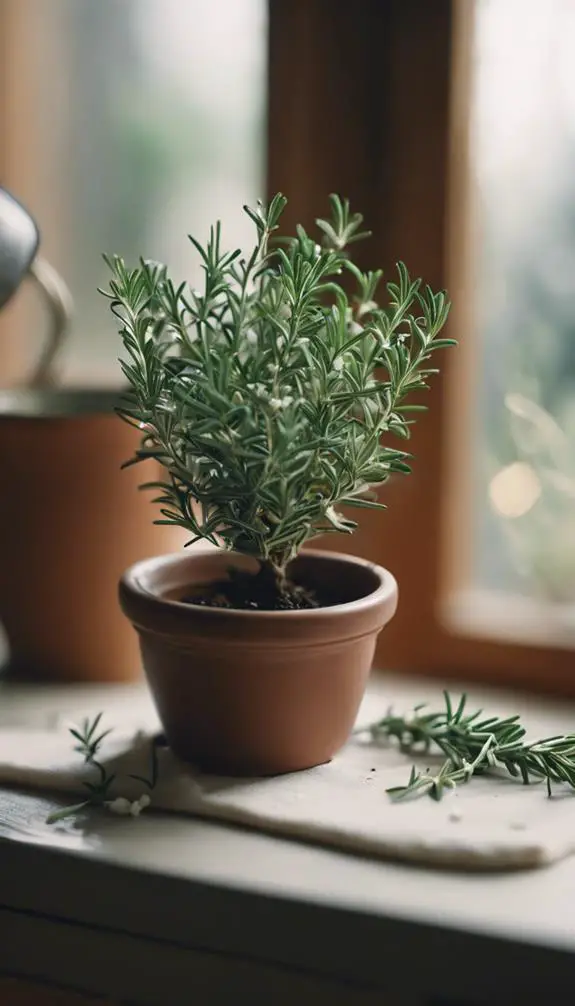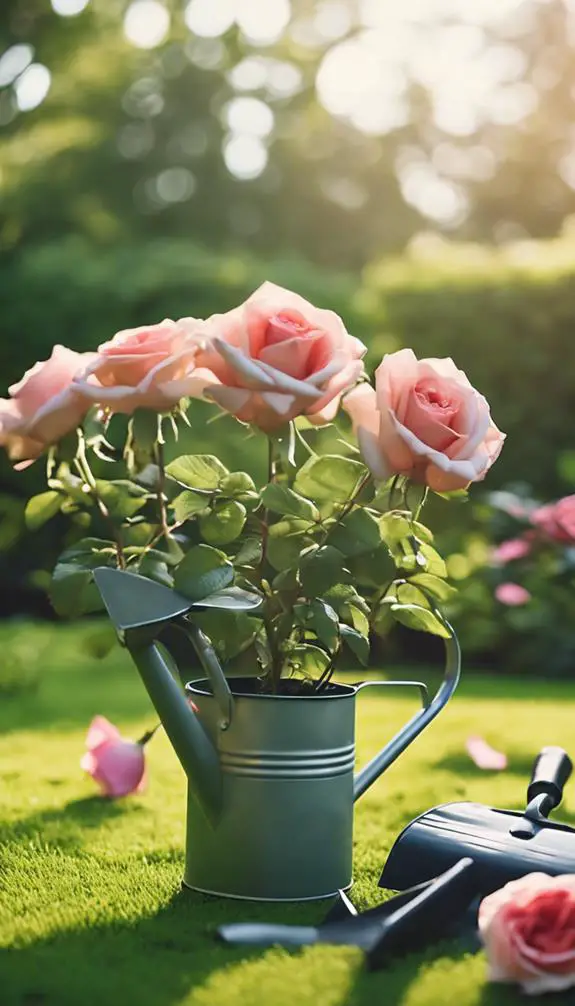You're interested in growing rosemary indoors, but where do you start? First, you'll need to choose a compact variety that's well-suited for indoor growing. Then, select a container with good drainage to prevent waterlogged soil. With those basics covered, you can start thinking about the perfect soil mix and how to provide the right amount of sunlight and water. But, what's the ideal temperature range for your rosemary plant, and how often should you fertilize it? The answers to these questions will set you on the path to successfully growing fragrant, flavorful rosemary right in your own home.
Summary
- Choose compact rosemary varieties like 'Hill Hardy' or 'Arp' for indoor spaces, and select ones with high climate tolerance like 'Tuscan Blue' or 'Miss Jessop's Upright'.
- Use a well-draining container with a mix of 60% peat moss or coconut coir, 20% perlite or vermiculite, and 20% compost or worm castings.
- Provide at least 4-6 hours of direct sunlight per day, or use grow lights with a blue spectrum, and maintain an ideal temperature range of 65-75°F (18-24°C).
- Water rosemary plants when the soil feels dry to the touch, and create a humid microclimate by placing the pot on a tray with water and pebbles or using a humidifier.
- Fertilize with a balanced, water-soluble fertilizer (20-20-20) every 1-2 weeks during the growing season, and prune regularly to promote healthy growth and prevent pest issues.
Choosing the Right Rosemary Variety

When selecting a rosemary variety for indoor growing, consider the mature size of the plant and its growth habits, as these factors will substantially impact its performance in a container.
You'll want to choose a rosemary species that's compact or dwarf, as they're better suited for indoor spaces. Look for varieties like 'Hill Hardy' or 'Arp', which are bred for their smaller stature and can thrive in containers.
Climate tolerance is also vital, as rosemary is sensitive to extreme temperatures. Opt for varieties with high climate tolerance, like 'Tuscan Blue' or 'Miss Jessop's Upright', which can withstand temperatures between 40°F and 80°F.
Selecting a Container With Drainage
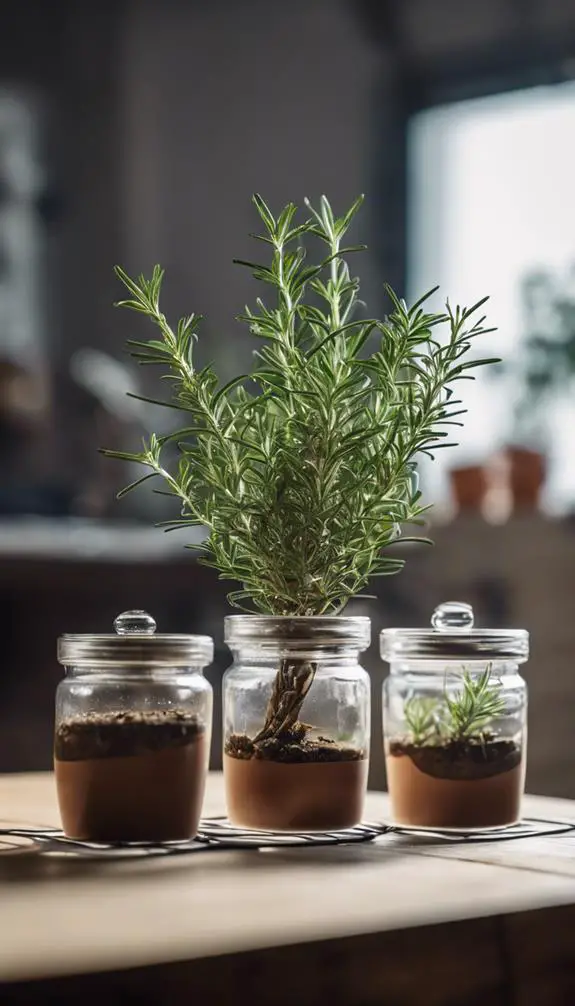
A well-draining container is essential for growing rosemary indoors, as this herb is prone to root rot if its roots are waterlogged.
You'll want to choose a container made from a material that allows for airflow and doesn't retain water, such as terra cotta, ceramic, or fiberglass. Avoid using plastic or metal containers, as they can cause water to collect and lead to root rot.
Look for containers with built-in drainage systems, such as holes in the bottom or a built-in water reservoir. If your container doesn't have a built-in drainage system, you can create your own by adding a layer of small rocks or broken pottery at the bottom to improve drainage.
Preparing the Soil Mixture
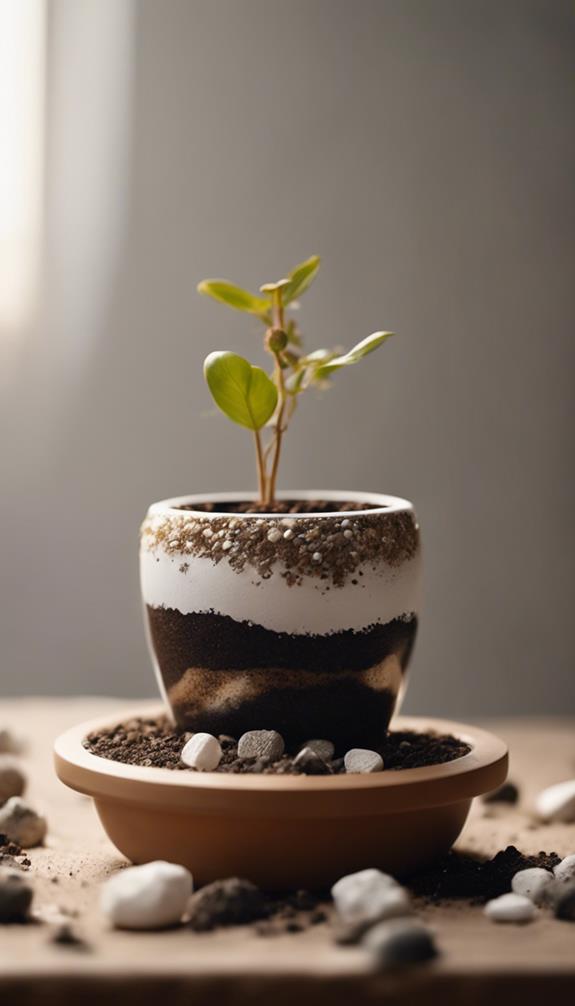
When preparing the soil mixture for your indoor rosemary, you'll want to choose ingredients that provide good drainage and aeration, as rosemary doesn't like wet feet.
Aim for a mix that's roughly 60% peat moss or coconut coir, 20% perlite or vermiculite, and 20% compost or worm castings.
You'll also want to guarantee the pH balance is ideal, between 6.0 and 7.0, to promote healthy root growth.
Soil Ingredients Matter
Precision is key when crafting a soil mixture for indoor rosemary, as the right blend can make all the difference in the health and vigor of your plants.
You'll want to create a well-balanced soil structure that allows for good drainage, aeration, and water retention.
To achieve this, mix in organic amendments like compost, peat moss, or perlite to improve soil porosity and fertility.
Aim for a ratio of 2 parts peat moss to 1 part perlite, with a dash of compost for added nutrients.
Avoid using regular potting soil, as it can be too dense and may cause waterlogging.
Optimal Ph Balance
Frequently, rosemary enthusiasts overlook the critical importance of pH balance in their soil mixture, which can lead to stunted growth and poor plant performance.
As you prepare your soil mixture, verifying the pH balance is crucial. Rosemary has acidic preferences, thriving in soil with a pH between 6.0 and 7.0.
To guarantee precision, calibrate your pH meter regularly. Take multiple readings to account for any variation, and adjust your mixture accordingly.
Aim for a slightly acidic to neutral soil pH, as this will promote healthy root growth and ideal nutrient uptake. By getting the pH balance right, you'll be well on your way to growing a thriving, fragrant rosemary plant indoors.
Obtaining Healthy Rosemary Cuttings
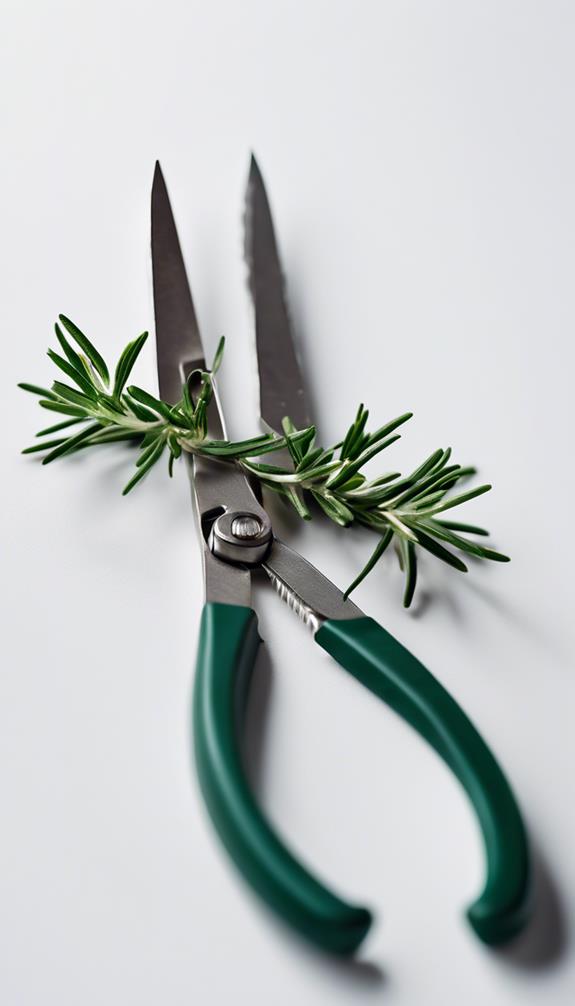
You'll need to select healthy stems with fresh growth and plenty of leaves to guarantee successful propagation.
Choose stems with a woody base and a tip with new growth, as these will root more easily. By taking cuttings from the right part of the plant, you'll increase your chances of propagating healthy rosemary plants indoors.
Selecting Healthy Stems
Three to five healthy stems with fresh growth are ideal for obtaining rosemary cuttings.
When selecting stems, inspect them for signs of disease, pests, or damage. Look for stems with a vibrant green color, sturdy texture, and a slight flexibility. Avoid stems with wilted or yellowing leaves, as they may not propagate well.
Perform a stem inspection by gently grasping the stem and checking for any cracks or brittle areas. Fresh cuttings are essential for successful propagation, so choose stems with new growth that's around 2-3 inches long.
Cut just above a node, where a leaf meets the stem, using clean scissors or pruning shears.
Propagating Cuttings Successfully
With cuttings in hand, it's time to focus on propagating them successfully.
You'll need to trim the cut ends using precise cutting techniques to promote root growth. Cut just above a node, where a leaf meets the stem, at a 45-degree angle. Remove lower leaves, leaving only a few at the top. This helps prevent rot and directs energy towards root stimulation.
Dip the cut end in rooting hormone powder or liquid to enhance root development. Plant the cutting in a well-draining potting mix, gently firming the soil around it. Water thoroughly, and maintain high humidity to support root growth.
Provide bright, indirect light and consistent temperatures between 65-75°F (18-24°C). With proper care, your cuttings will develop robust roots, paving the way for a thriving indoor rosemary plant.
Planting the Rosemary Cutting

Since you've successfully prepared your rosemary cutting, it's now time to plant it.
Fill a small pot with a well-draining potting mix, leaving about an inch at the top for watering.
Gently remove the cutting from its propagation medium, taking care not to disturb the roots. If the roots have become root bound, gently tease them apart with your fingers or a blunt instrument to encourage growth.
Plant the cutting at the same depth as it was previously, and water gently but thoroughly.
To minimize plant shock, keep the soil consistently moist but not waterlogged during the first few weeks after planting. Monitor for signs of stress, and adjust your care routine accordingly.
Providing Adequate Light Sources

Rosemary requires abundant light to thrive, and indoors, it's essential to provide it with the right amount and type of illumination.
You'll want to place your rosemary plant in a spot that receives direct sunlight for at least 4-6 hours a day.
If that's not possible, consider using Natural Lighting Options like south-facing windows or skylights.
For Low Light Solutions, you can use grow lights, which come in a range of spectrums and intensities.
Aim for LED grow lights with a blue spectrum, which promotes healthy leaf growth.
Position the lights 6-8 inches above the plant, and adjust as needed.
Maintaining Optimal Temperature
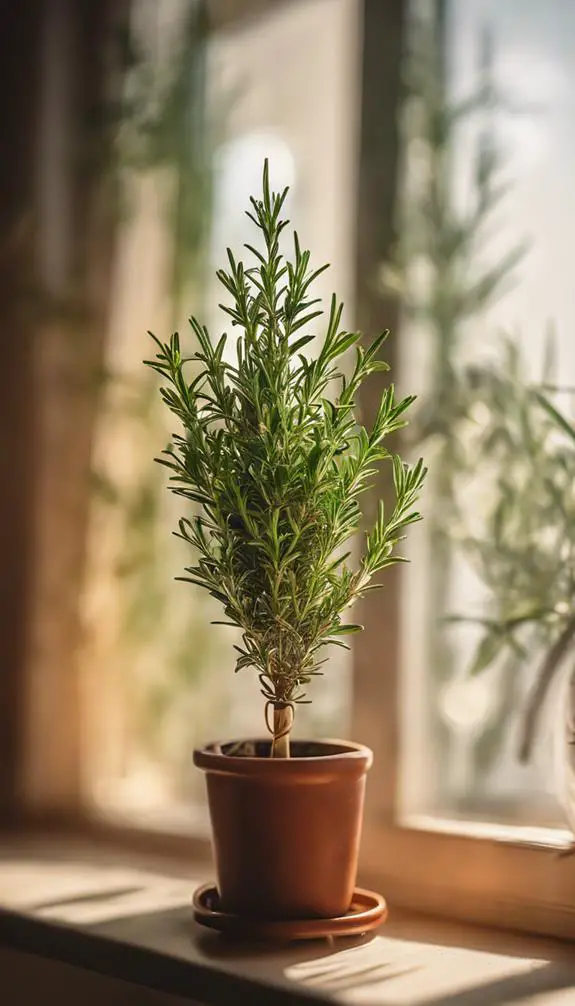
You'll want to maintain an ideal temperature range of 65-75°F (18-24°C) for your indoor rosemary plant, as this allows for peak growth and development.
It's also important to provide cooler nighttime temperatures, around 55-65°F (13-18°C), to simulate the natural temperature fluctuations that occur outdoors.
Ideal Temperature Range
Temperature control is crucial for indoor rosemary growth, as it profoundly impacts the herb's development and overall health.
You'll want to maintain an ideal temperature range between 65°F to 75°F (18°C to 24°C) during the day. This allows your rosemary to thrive and promotes healthy growth.
Be aware that temperature fluctuations can lead to stress, which can weaken your plant's immunity. Rosemary has a moderate winter tolerance, but sudden drops in temperature can still cause damage.
Keep your indoor rosemary away from drafty windows and doors to prevent temperature swings. By maintaining a consistent temperature, you'll create a prime environment for your rosemary to flourish indoors.
Cooler Nighttime Temps
While your indoor rosemary plant requires a consistent temperature range during the day, it's equally important to maintain ideal nighttime temperatures.
As the sun sets, your rosemary plant benefits from a slight drop in temperature, mimicking the natural Winter Chills it would experience outdoors. Aim for a temperature range of 55-65°F (13-18°C) during the night, which is slightly cooler than the ideal daytime temperature.
This Cooler Climate will help promote healthy growth, prevent disease, and encourage root development. By maintaining this temperature differential, you'll create a perfect environment for your rosemary plant to thrive indoors.
Avoiding Extreme Fluctuations
In proximity to heating vents or drafty windows, your rosemary plant may be exposed to extreme temperature fluctuations that can hinder its growth.
To avoid this, you'll need to maintain ideal temperature consistency. Aim for a climate control between 65°F to 75°F (18°C to 24°C) during the day and no lower than 55°F (13°C) at night.
Keep your plant at least 3-4 feet away from heating vents and drafty windows to minimize temperature fluctuations. By doing so, you'll guarantee your rosemary plant receives the consistent temperature it needs to thrive.
Watering and Humidity Control
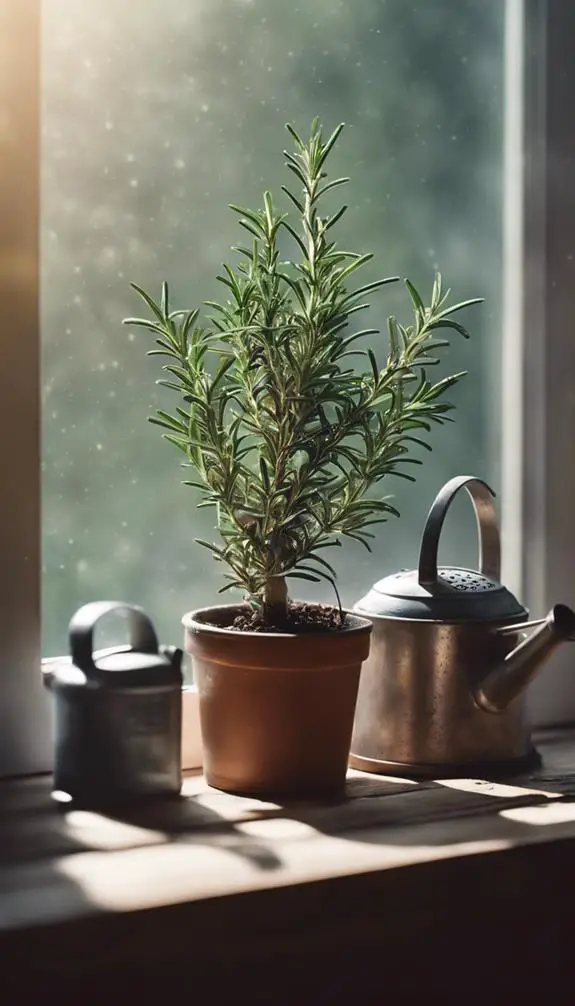
With rosemary's Mediterranean origins, it's no surprise that this herb thrives in conditions that mimic its native habitat, where water is scarce and humidity is moderate.
You'll want to simulate this environment indoors by allowing the soil to dry slightly between waterings. Avoid overwatering, which can lead to root rot and other issues.
Instead, aim to induce water stress, which will encourage the plant to develop stronger roots and a more robust flavor.
To create a humid microclimate, place the pot on a tray filled with water and pebbles or use a humidifier nearby.
This will maintain the ideal humidity level, typically between 40-60%, and promote healthy growth.
Fertilizing Indoor Rosemary Plants
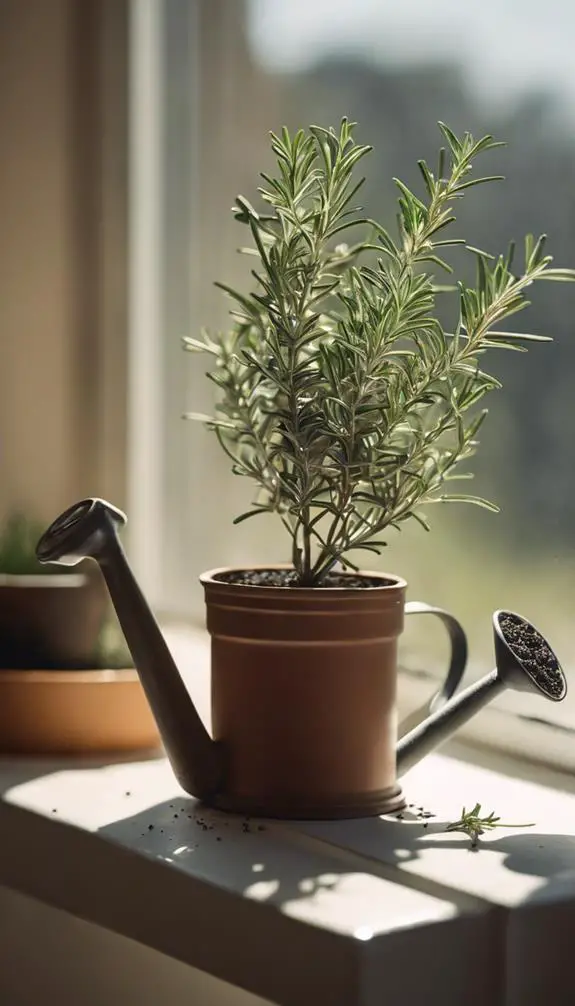
Your rosemary plant's nutrient intake plays a crucial role in its overall health and flavor profile.
To provide your indoor rosemary with the necessary nutrients, you'll need to fertilize it regularly. A balanced, water-soluble fertilizer (20-20-20) is ideal for rosemary plants.
You can fertilize your rosemary every 1-2 weeks during the growing season (spring and summer) and once a month during the dormant season (fall and winter). Dilute the fertilizer to half the recommended strength to prevent burning the roots.
Stick to a consistent fertilizer schedule to guarantee your rosemary receives the necessary rosemary nutrients for peak growth and flavor. A well-fertilized indoor rosemary plant will reward you with fragrant leaves and a robust flavor profile.
Pruning for Shape and Size

Rosemary's bushy shape and compact size are easily maintained through regular pruning, which also promotes healthy growth and encourages the plant to produce more fragrant leaves.
To prune, you'll want to pinch or cut off the tips of the stems to encourage a bushy formation and increase Rosemary density. This will stimulate the plant to produce new growth and prevent it from becoming leggy.
Remove any weak or spindly stems, and trim back the plant to the desired shape.
Prune your Rosemary plant regularly, ideally every 4-6 weeks, to maintain its shape and size. By doing so, you'll be rewarded with a lush, fragrant, and compact indoor Rosemary plant.
Pest and Disease Prevention
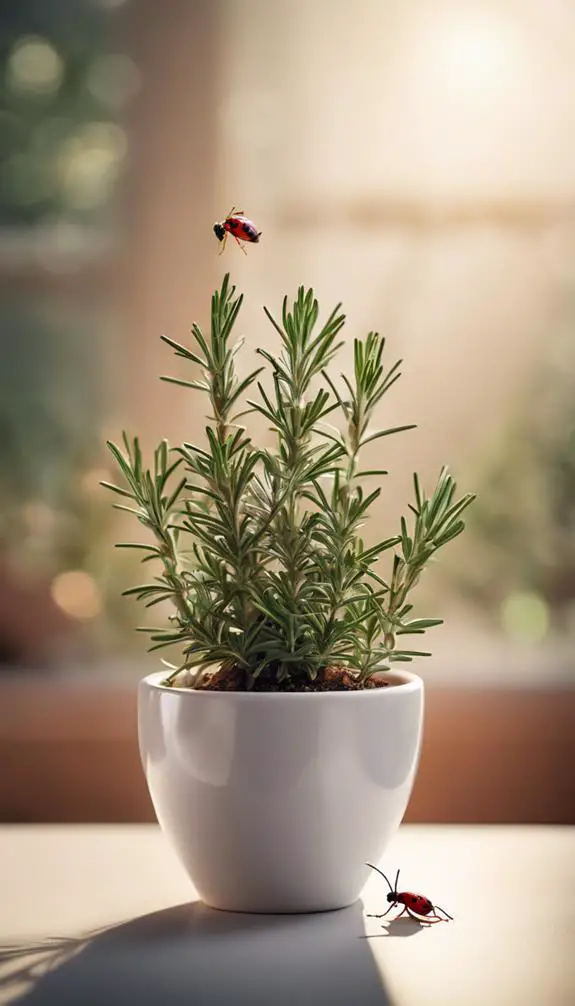
Regular pruning helps prevent pest and disease issues by increasing air circulation and reducing humidity around the plant, creating an environment that's less conducive to infestations and infections.
You'll also need to perform regular pest inspections to catch any potential issues early. Check for signs of pests like spider mites, mealybugs, and aphids, and treat promptly if you find any.
Fungus management is also vital, as rosemary is susceptible to root rot and leaf spot. Guarantee good drainage, avoid overwatering, and remove any infected leaves or stems to prevent the fungus from spreading.
Propagating New Rosemary Plants

Three to five cuttings from a mature rosemary plant can be taken at any time, provided it's healthy and thriving.
Cut 2-3 inch stems from the tips of the branches, just above a node. Remove lower leaves, leaving about an inch of stem and a few leaves at the top.
Dip the cut ends in rooting hormone to stimulate root growth. Plant the fresh clippings in a well-draining potting mix, gently firming the soil around them. Water thoroughly and provide indirect sunlight.
Keep the soil consistently moist but not waterlogged to promote root stimulation. Within 2-3 weeks, roots should develop, and you'll have new rosemary plants to enjoy.
Common Problems and Solutions
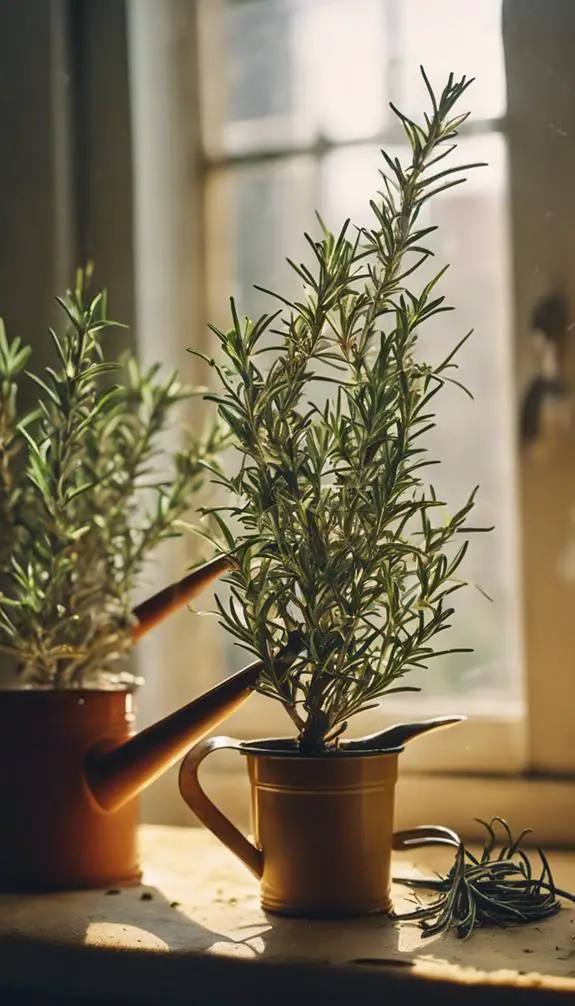
Several common issues can arise when growing rosemary indoors, and being aware of them can help you take corrective action promptly.
One of the most prevalent problems is overwatering, which can lead to root rot and fungal diseases. Check the soil regularly to verify it's not waterlogged, and adjust your watering schedule accordingly.
If you notice yellowing leaves or black spots, it may be a sign of fungal disease. Treat the plant with a fungicide and improve air circulation to prevent the spread of the disease.
You can also prune affected areas to prevent further damage. By being vigilant and taking prompt action, you can prevent these issues from taking hold and keep your rosemary plant thriving.
FAQs
Can I Grow Rosemary Indoors Year-Round Without Outdoor Transplantation?
You can successfully grow rosemary indoors year-round without outdoor transplantation by maintaining precise climate control and optimizing lighting conditions, ensuring consistent temperatures between 65-75°F and providing 4-6 hours of direct sunlight or 12-14 hours of indirect light.
How Often Should I Repot My Indoor Rosemary Plant?
You'll need to repot your rosemary plant when it becomes root-bound, typically every 6-12 months, to refresh soil quality, as old soil can hinder growth; choose a well-draining potting mix and a slightly larger pot to give roots room to expand.
Will Indoor Rosemary Plants Attract Beneficial Pollinators Like Bees?
You'll be pleased to know that indoor rosemary plants can attract beneficial pollinators like bees, as they're naturally bee-friendly; however, this is crucial to maximize pollinator attraction by providing sufficient light, temperature, and humidity for these tiny visitors.
Can I Use Essential Oil From Store-Bought Rosemary for Cooking?
You can use store-bought rosemary essential oil for cooking, but it's not ideal; instead, opt for fresh herbs or explore oil substitutes like infused oils or flavorful extracts, which offer more nuanced flavors and aromas.
Do Indoor Rosemary Plants Require Air Circulation for Healthy Growth?
You'll want to guarantee your indoor rosemary plant receives adequate air circulation; place it near a window with a gentle breeze or use a fan for circulation, as stagnant air can lead to root rot and poor growth.
Conclusion
By following these steps, you'll be well on your way to growing a thriving rosemary plant indoors. Remember to monitor temperature, light, and watering conditions to guarantee ideal growth. Regular pruning and fertilization will promote a bushy shape and robust flavor. With proper care, your indoor rosemary plant will provide fresh herbs year-round, and you can even propagate new plants to share or expand your indoor garden.


